A runner's guide to choosing the right toebox
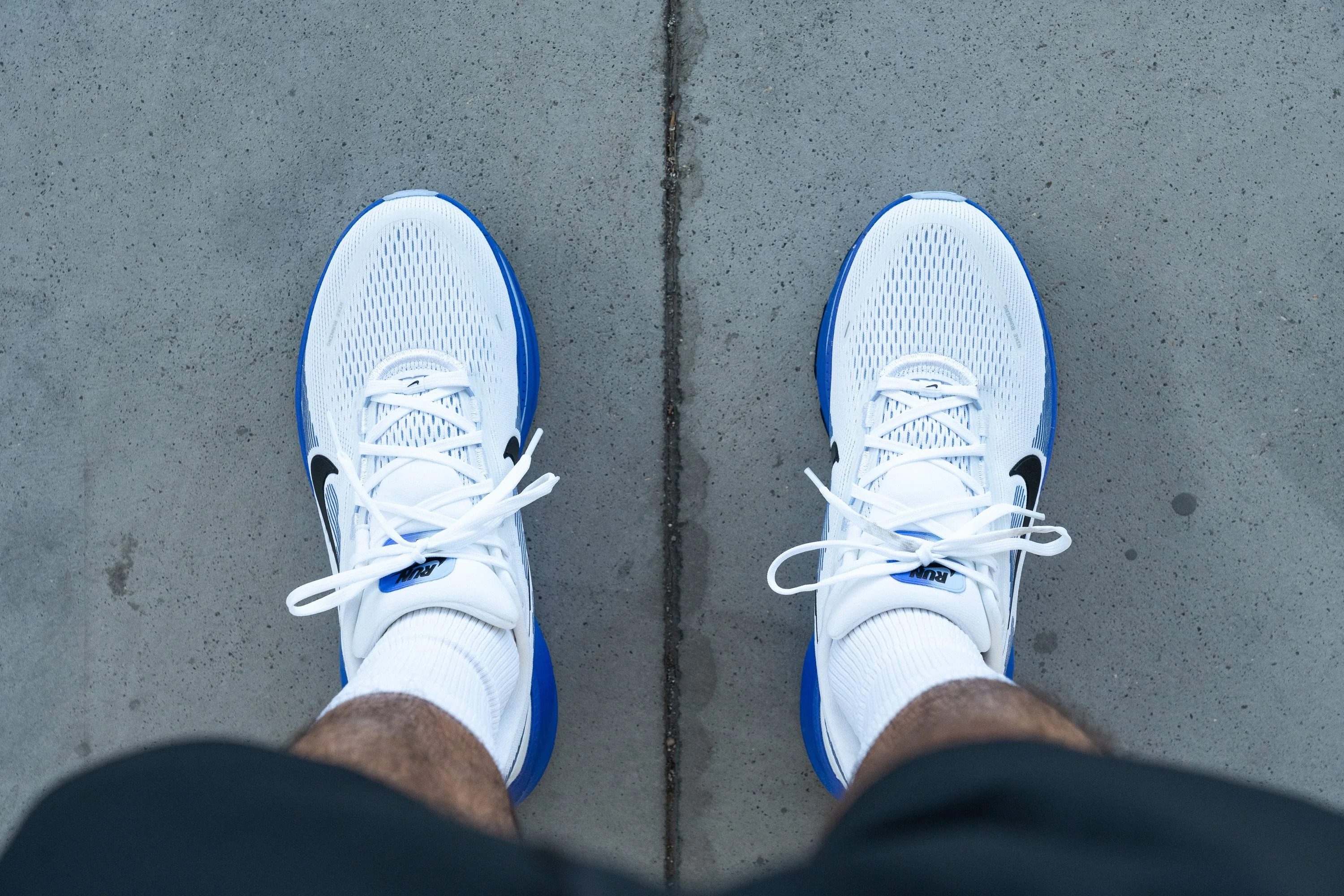
While the toebox might not be the most prominently featured aspect in the marketing of running shoes, it plays an essential role in determining the quality and comfort of your run. It's not just a matter of fit; the toebox can influence everything from the mechanics of your stride to the level of support and space your feet receive.
In this guide, we will explore the subtle yet important details that establish the toebox as a crucial component of running shoes. You'll gain insights into how it affects your running experience, what to look for in a toebox depending on your foot shape and size, and why it deserves more attention than it typically gets.
How we measure the interior of every running shoe in the lab

Most running shoe reviews online rely on subjective impressions—reviewers run for a few days and then describe the fit as “roomy” or “tight.” That’s fine for quick feedback, but it’s hardly reliable or scientific. For example, what happens when your feet expand on a hot day or after hours of running?
That’s why we spent months developing a custom gel-based method to accurately measure the interior of every running shoe. We ran multiple tests on the same model, adjusting the gel formula and cooling process until we achieved perfectly consistent results.
Our approach offers three key advantages: it treats every shoe equally, it’s fully data-driven, and it provides three precise measurements—two for width and one for height.
Width / Fit
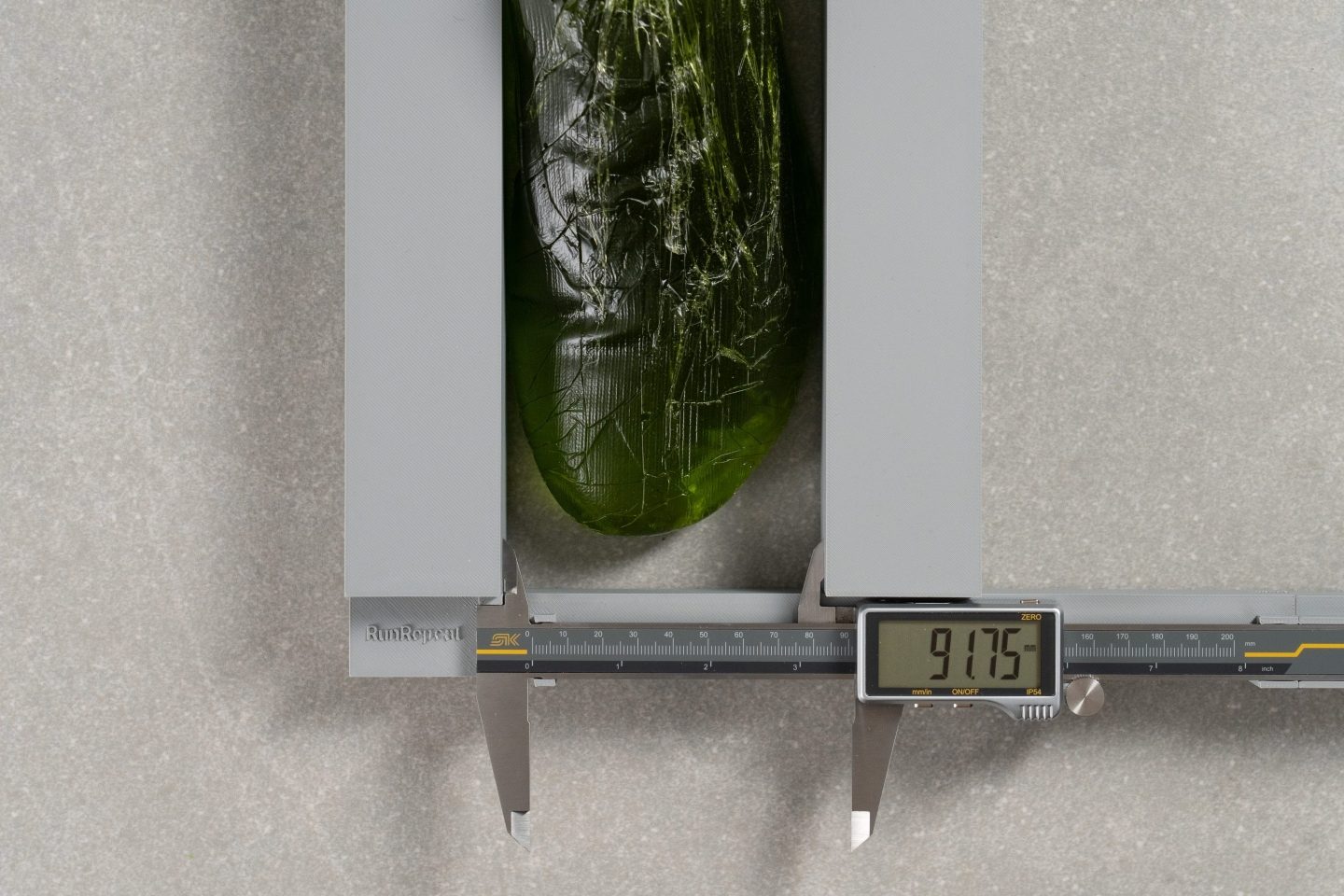
The first of our three measurements is taken at the widest part of the shoe’s interior.
If you’re a runner who often feels pressure around the ball of the foot, this metric helps you find a model with enough room. Conversely, if you prefer a snug, performance-oriented fit, you’ll now have precise data to guide your choice.
Toebox width

The second measurement captures the width of the toebox. We take it at the exact same point in every shoe using a custom-made placeholder to ensure consistency.
This is arguably the most important metric for most runners, as many fit issues stem from a narrow toebox that restricts toe splay and causes pressure on the toes. Whether you need extra room for comfort or a snug, race-ready fit, this is the key measurement to watch.
Toebox height
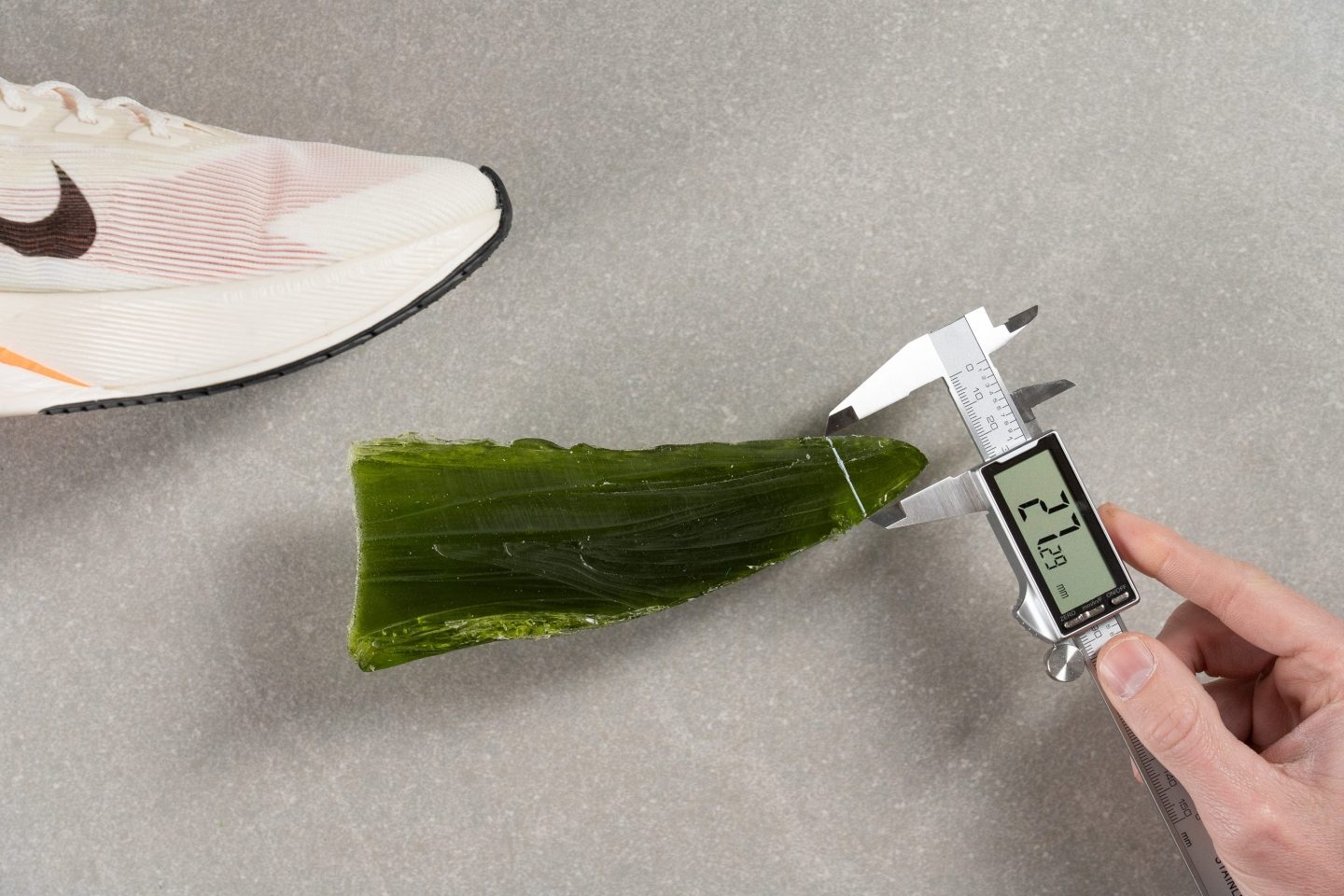
Our final interior measurement is the toebox height. While it may not matter to everyone, many runners find shoes either too restrictive on the toes or, conversely, too spacious and unstable.
With this measurement, you can choose the toebox height that best suits your preferences—whether you prioritize comfort, a locked-in fit, or a balance of both.
The importance of the toebox in running shoes
Navigating the complexities of toebox design begins with a fundamental understanding: every foot is unique, a fact you've likely observed yourself.
Just spend a day at the beach or a pool, and you'll see a diverse array of foot shapes and sizes. How do running shoe designers manage to accommodate such variety? The reality is, they aim to satisfy a broad segment of runners, but that leaves some individuals less than comfortable.
How an ill-fitting toebox can lead to issues or injuries
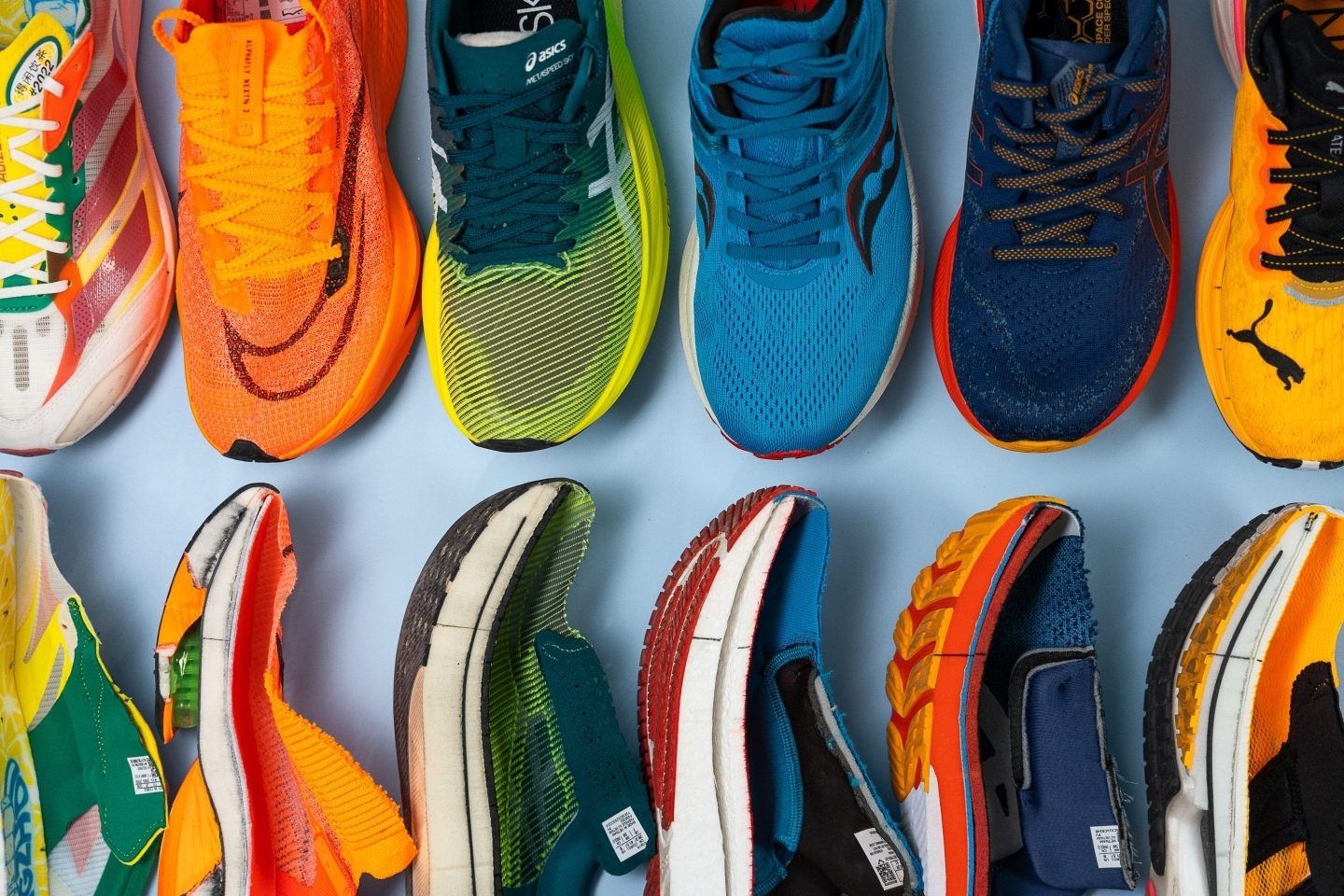
Choosing the wrong toebox can indeed lead to injuries, ranging from minor discomfort to more severe issues. Most often, you'll detect these problems early on, thanks to noticeable symptoms. However, it's crucial to pay attention to these early warning signs and take action.
If you suspect that your discomfort stems from an ill-fitting toebox, switching back to a pair of shoes that you know fits well usually resolves minor issues quickly. Logically, it's wise to stop using that particular shoe model. Perhaps consider passing them on to a friend for free or donating them!
Consequences of a tight toebox
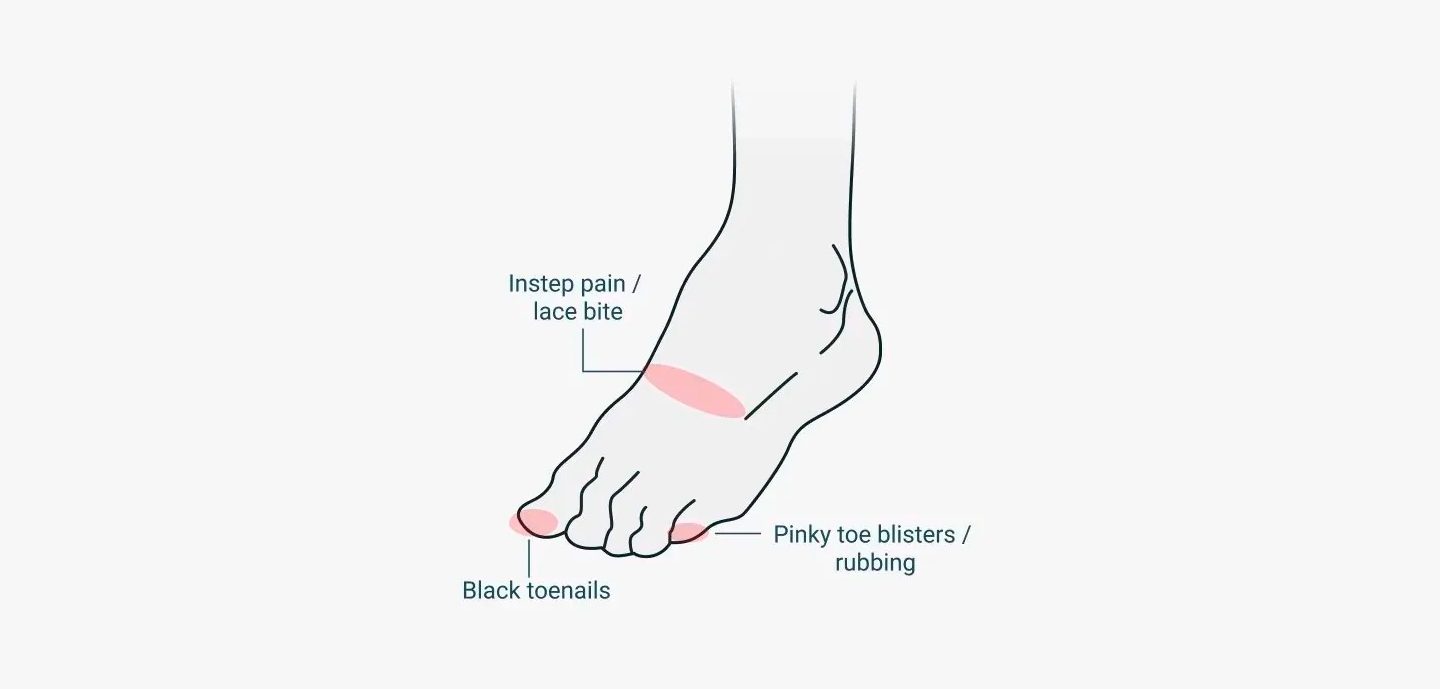
Up next, we'll explain the most frequent injuries you could encounter when opting for a shoe with a narrow toebox. Our aim is to arm you with the knowledge you need to sidestep these common setbacks. Additionally, whenever possible, we'll offer alternative solutions that could allow you to continue wearing your chosen pair without discomfort.
Note: in this section we'll frequently refer to various alternative lacing techniques by name. You can find detailed explanations for each of these methods in our Running Shoe Lacing Techniques guide.
| Injury / Problem | Description | Possible solution |
| Ingrown toenails | Excessive pressure on toenails may lead to inward growth into the skin | Choose a different pair of running shoes that offers a rounded or foot-shaped and spacious toebox |
| Morton's Neuroma | Tissue thickening around a nerve, usually between the third and fourth toes, causing pain | Try a lacing technique designed for wide forefoot or toe pain to create extra room, or switch to a shoe with a wider toebox and lower heel-to-toe drop |
| Black Toenails | Sustained pressure against the toenail can result in bruising or nail loss | Begin with thinner socks and utilize a heel-slipping lacing technique with the same shoe. If the issue persists, consider a larger size or a shoe with a wider toebox. Avoid carbon-fiber plates and firm midsoles if possible |
| Metatarsalgia | Inflammation and pain in the ball of the foot | Replace the insole with a more cushioned one that provides better arch support. If the problem continues, opt for a soft midsole |
| Painful corns and calluses | While often not painful initially, and even a badge of honor for some runners, corns and calluses can become painful and may worsen over time | Use cushioned insoles and switch to shoes featuring a more accommodating toebox |
| Hallux Rigidus | Arthritis in the big toe that causes stiffness, pain, and limited joint movement | Opt for a running shoe with a rockered shape and a spacious toebox to relieve pressure |
| Hallux Valgus (bunions) | Tight shoes may cause a bony protrusion on the side of the big toe, which may push the other toes toward each other | Invest in a running shoe that has a wide toebox, or select the wide-width option of a shoe you already enjoy |
| Blisters in the big or pinky toe | Friction between the foot and shoe may result in painful, sometimes blood-filled, blisters | For issues with the pinky toe, a more naturally rounded toebox usually suffices. For the big toe, a wider toebox is the way to go |
| Lace bite | Excessive pressure on the instep can result in discomfort or pain in that region | Choose a lacing method tailored for broad forefoot or toe discomfort to increase space, or consider transitioning to shoe with a more padded tongue |
Consequences of a loose fit
Running in shoes where the toebox is too roomy can lead to real trouble. Imagine your feet moving side to side and front to back with every step you take. This isn't just uncomfortable—it's risky. Loose shoes can disrupt your natural stride, throwing off your form and leading to minor or even major injuries.
Blisters are often the first sign of a problem, forming from constant rubbing. And if your toes are always hitting the front of your shoes—especially during downhills—, say hello to black toenails. Plus, when your toes have to cling like claws to stabilize your foot and prevent pronation, conditions like hammer toes and bunions can develop.
And your ankles are also at risk! They need a good fit for support, and without it, you're more likely to twist or sprain them in both road and trail running.
Toebox data insights
The advantage of our lab work is that we have meticulously cut and measured hundreds of shoes. This allows us to offer you exclusive snippets and insights regarding toebox construction and design.
Relationship between the maximum width of the upper and the big toe area
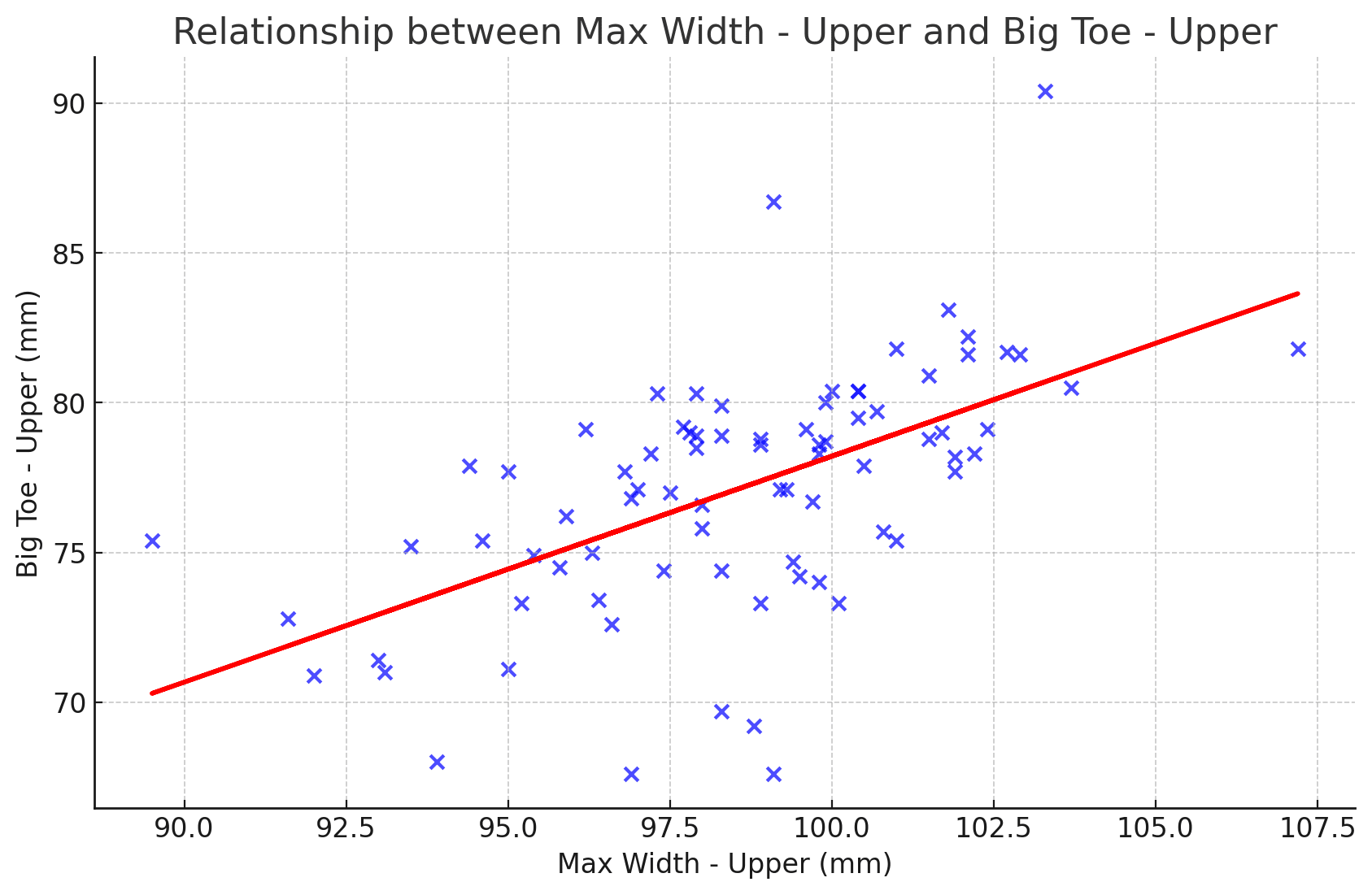
The correlation coefficient of 0.57 suggests a moderate positive relationship between the two variables. This indicates that an increase in the maximum width of the upper is generally accompanied by an increase in the measurement for the big toe in the toebox.
Nevertheless, we have observed the presence of some outliers:
| Shoe | Max width (mm) | Big toe (mm) | Predicted big toe (mm) | Change (mm) |
| Adidas Adizero Adios 7 | 99.1 | 67.6 | 77.5 | -9.93 |
| Nike Quest 5 | 98.3 | 69.7 | 76.9 | -7.23 |
| Adidas Runfalcon 2.0 | 98.8 | 69.2 | 77.3 | -8.11 |
| Saucony Axon 2 | 96.9 | 67.6 | 75.9 | -8.27 |
| Altra Torin 7 | 103.3 | 90.4 | 80.7 | +9.70 |
| Altra Paradigm 7 | 99.1 | 86.7 | 77.5 | +9.17 |
While the majority of shoes adhere to a normal design, certain models break the mold.
It's not surprising, given that brands like Adidas, Saucony and Nike are known for their snug, form-fitting footwear across numerous models. On the other hand, Altra is renowned for its anatomically designed toeboxes, a feature we will explore in detail later in this guide.
Relationship between the upper width and the price of running shoes
Are wider running shoes more expensive or less? Let's find out and make sense of what we see. We used all our data to show how the width of the running shoe's upper part is related to its price.
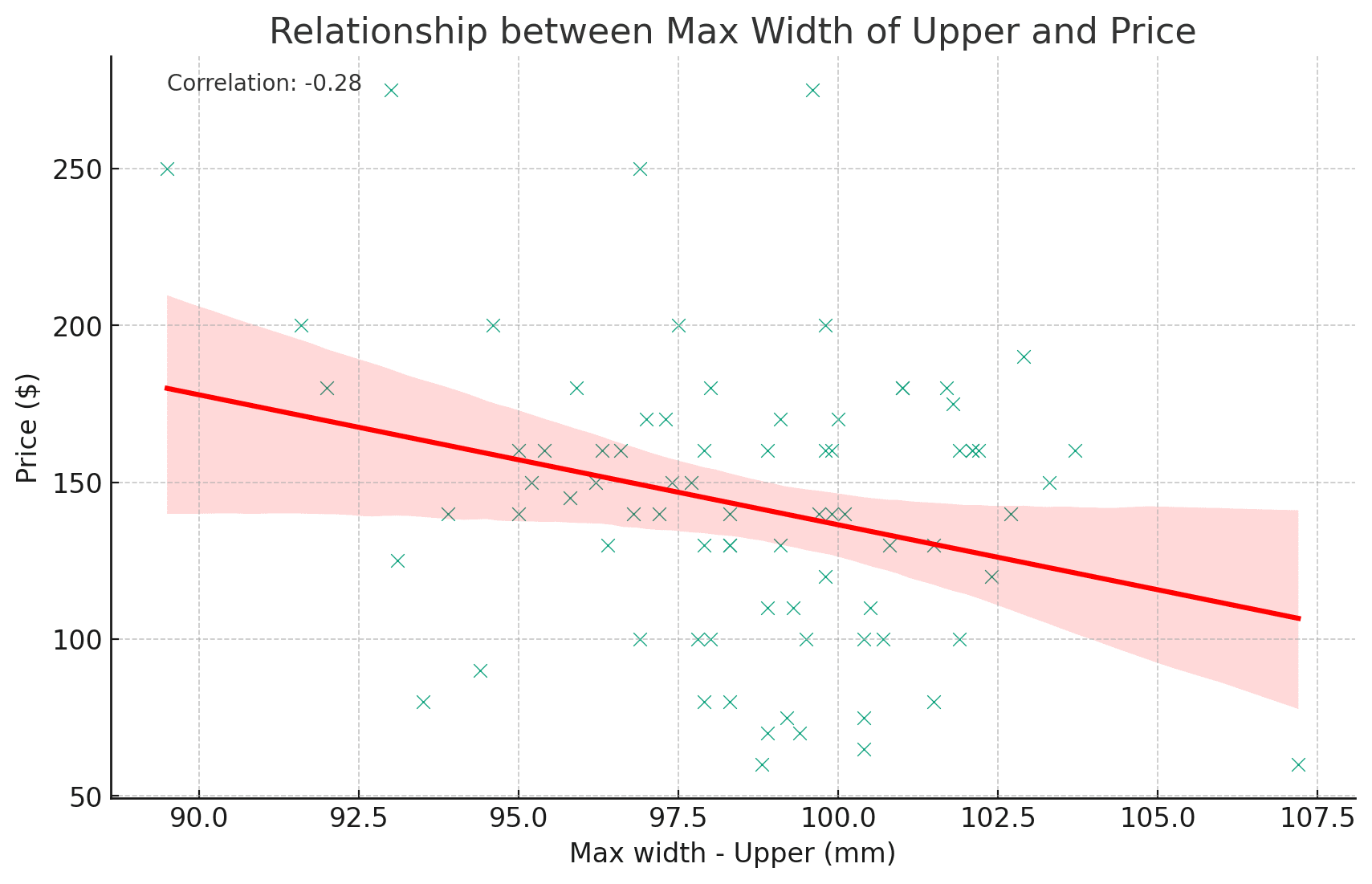
The red line on our chart shows the overall trend between shoe width and price.
We also found out that the relationship between shoe width and price is slightly negative at -0.28, which means that generally, as the shoe gets wider, it gets cheaper.
This usually happens because the most expensive running shoes are those made for races or tempo training. Daily running shoes, which are wider to provide comfort, tend to cost less as most of them don't have fancy technologies like superfoams or carbon plates.
Correlation between the width of the toebox and the width of the midsole
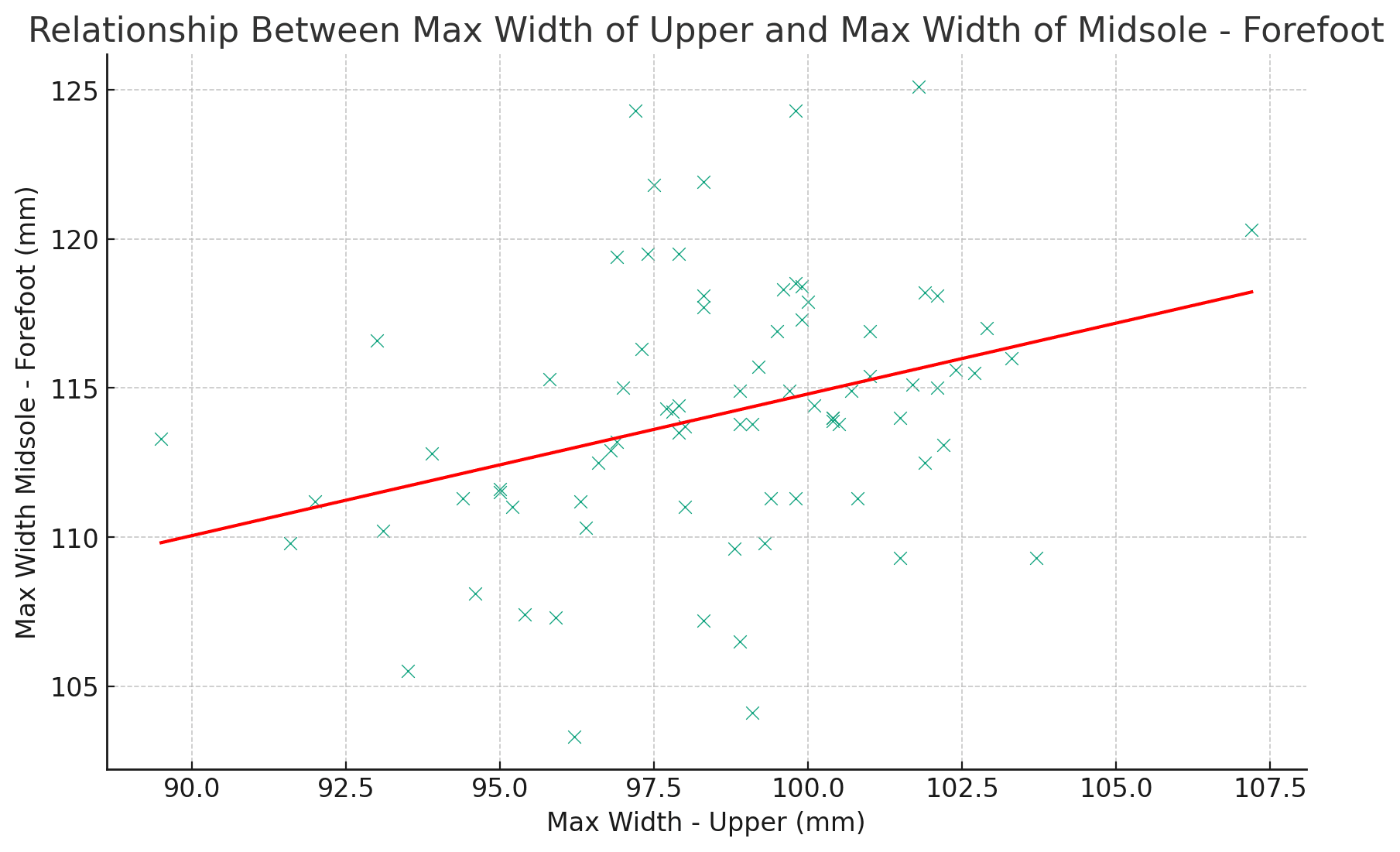
The final exploration into analytics in this guide focuses on the connection between the toebox's maximum width and the midsole's width.
Our findings indicate a clear correlation (0.33) between these two aspects. As the toebox's maximum width grows, the midsole's maximum width in the forefoot area tends to expand as well.
It's worth noting that, as always, there are outliers. Many of these exceptions are shoes that use a smart trick to enhance stability by pairing a very wide midsole with a comparatively narrow upper, such as the ASICS Superblast.
Running shoe widths explained

Running shoe widths are an essential aspect of finding the perfect fit for your feet. Some shoes come in a range of widths to accommodate the natural variation in foot shapes and sizes among the population: A, B, D, 2E, 4E, and so on.
The standard width for women's shoes is B, while D is considered standard for men. This difference acknowledges the general anatomical differences between men's and women's feet, where women's feet tend to be narrower relative to their length. In contrast, men's feet tend to be broader, hence the wider standard width. However, women have wider heels.

For women, widths typically range from A, which is the narrowest option, through B, D, and up to E, 2E, and 4E, with 4E being the widest available. For men, the scale starts at B, moving up through D (standard), to 2E and 4E, and even up to 6E for exceptionally wide feet. Nonetheless, it’s extremely rare to see an A or 6E running shoe.
A width of 2E for men and D for women is considered wide. It provides a roomier fit for those with broader feet. A 4E width for men and a 2E width for women are classified as extra-wide, offering even more space for toe splay.
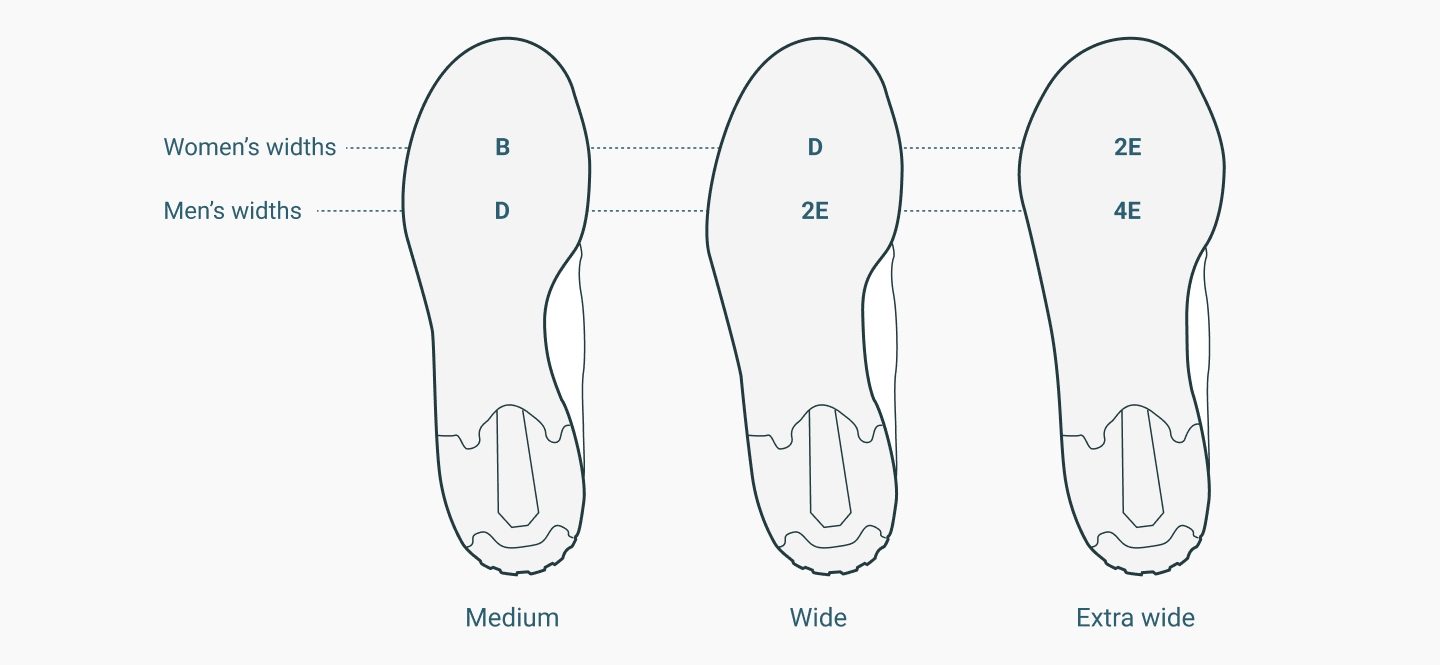
There are now two useful tips to keep in mind:
- Women with wide feet may sometimes find a better fit in men's shoes, and men with narrower feet might prefer women's shoes due to the difference in sizing systems between genders.
- Most brands use the same last and just slightly increase the fabric in the upper to create wide sizes, especially if we talk about women's D, or men's 2E. So, in most shoes, you shouldn't expect a wider landing platform—just a wider fit due to the upper adjustments.
How each category of road running shoes should fit in the toebox
At RunRepeat, we divide the road running shoes into three main categories: daily running, tempo runs and competition. It's important for you to remember that not every shoe will fit your feet the same way. Hence, you should also employ a multi-pair shoe rotation.
Daily running shoes
Daily trainers prioritize comfort above all, which is why many brands offer these shoes in wide sizes—they understand that the key is to feel good during a run, with performance taking a back seat.

Aim for a comfortable fit, but avoid a fit that's too loose. As previously mentioned, that can cause problems, and you want a shoe that will endure for over 500 miles. A tight, "race-day" fit isn't advisable, particularly in the summer when feet tend to swell during long runs.
Tempo training shoes
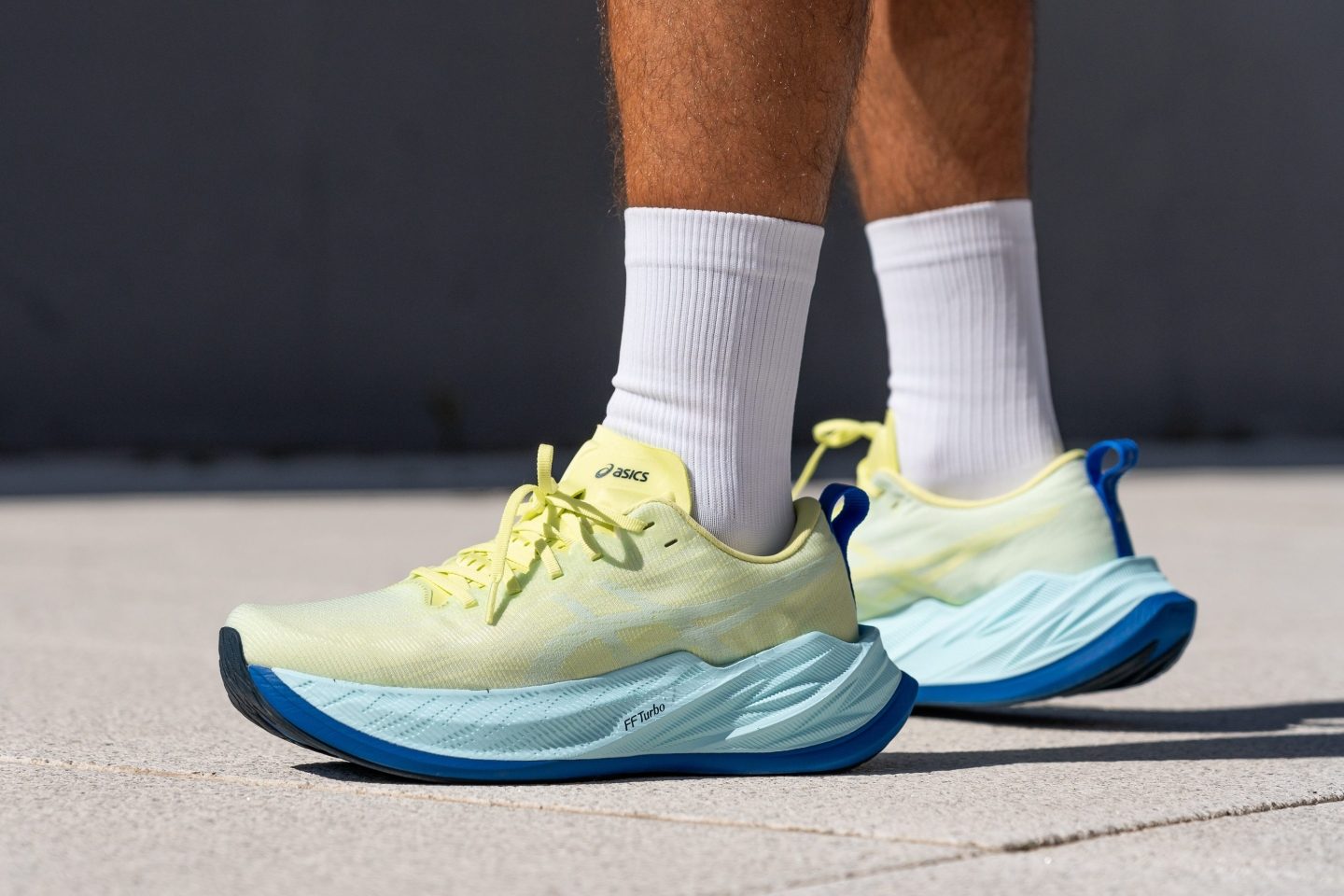
Shoes in this category strike a balance between being lighter and quicker, while still providing comfort. The fit should reflect this middle ground—not as roomy as a daily trainer but more forgiving than a racing shoe, considering you'll likely wear them frequently, including during quicker long runs.
If you're unsure, a good guideline is to choose a fit that's 1-to-3 mm narrower than your training shoes. Alternatively, you can fine-tune the fit by adjusting the thickness of your socks, a tip we’re covering later in this same guide.
Competition shoes
A Ferrari is built for speed, not comfort, much like racing shoes, which are typically narrow and rarely available in wide sizes.
When you first slip into racing shoes, they may feel unusually tight, especially if you're accustomed to the roomier fit of training or tempo shoes. It's crucial not to make direct comparisons, as racing shoes are designed exclusively for competition where performance is paramount.
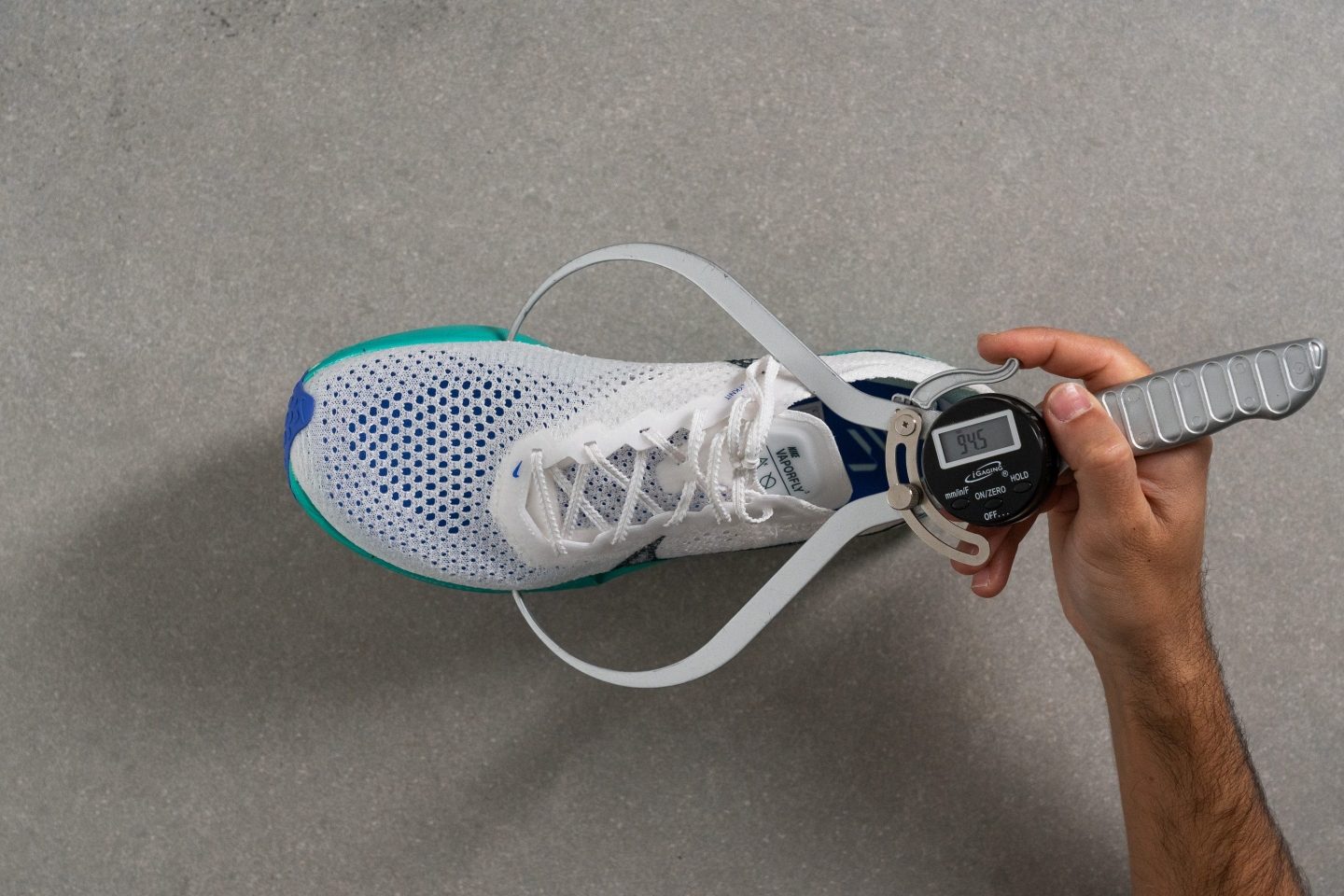
Take the Nike Vaporfly 3, for example. Its mind-blowing design is intentional, and it's meant to fit snugly—that's a sign of a race-ready shoe. A racing shoe that feels spacious is likely too big, compromising the intended high-performance fit. However, remember that a snug fit shouldn't be confused with being too small.
Finally, there’s a caveat. When participating in ultras—going far beyond the marathon length—it is prudent to prioritize comfort over a more aggressive, performance-oriented fit, as well as going at least half-size up if you’re not planning on changing shoes every few hours.
This consideration is key to prevent potential issues that may arise during the extended hours of running, such as after 3, 4, or even 5 hours of continuous movement.
DIY fit test
No matter the shape of your feet, you can perform a straightforward check to ensure the toe-box provides enough room, just as we explained for shoe size.
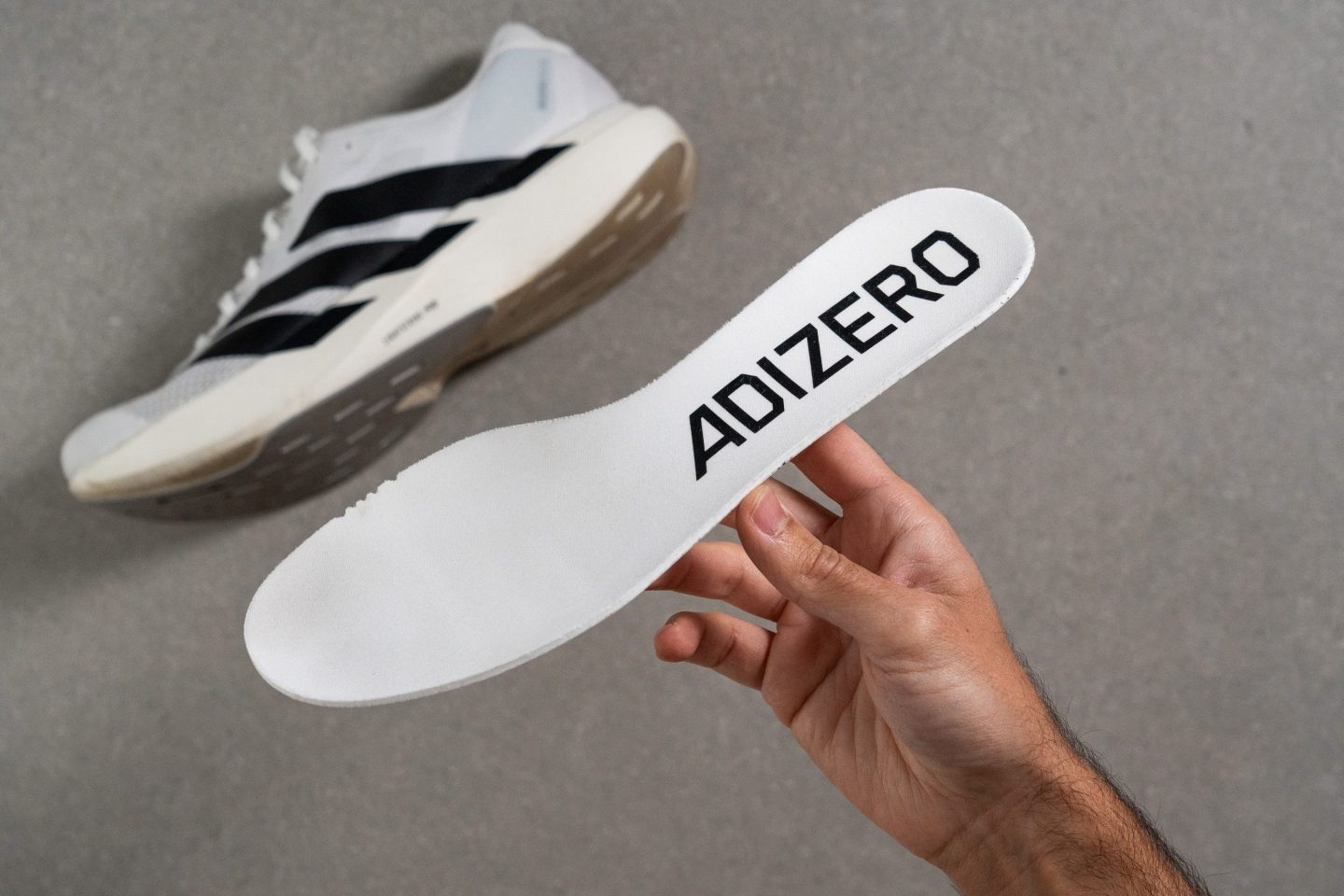
Here's how: Take out the insoles from your shoes and place them on the floor. Stand on these insoles with your full weight distributed as it would be while you're running. Look down at your feet; if no part of your feet hangs over the edges of the insoles, then the toe-box likely offers an adequate space for your feet.
This simple test is a preliminary indicator that the shoe may suit your foot's width. If your feet spill over the insoles, it's a sign that the shoe may be too narrow.
Toebox height: does it really matter?
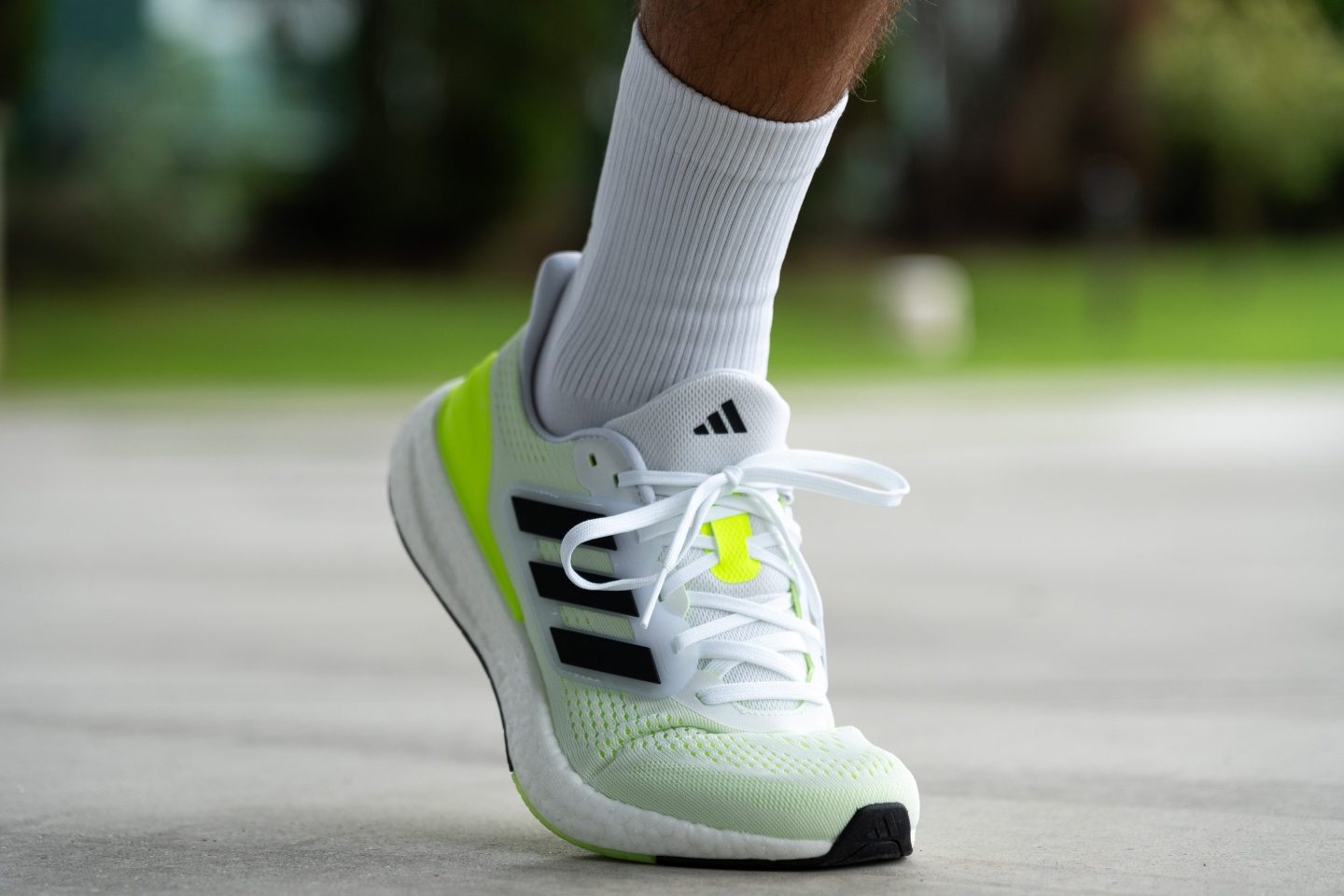
For runners who frequently suffer from black toenails, often a result of their big toe pointing upwards while running, toebox height becomes more than a minor detail—it can be a source of ongoing frustration.
However, it's crucial to understand that the height of the toebox isn't typically the main issue—it's the material used in the upper. Certain shoes feature stiff TPU overlays on the upper that might seem fine when you first slip on the shoe or during short runs, but they can become problematic during longer distances, like marathons or ultras.
The reason? Your toes could repeatedly strike these rigid overlays thousands of times, which can lead to injury over time.
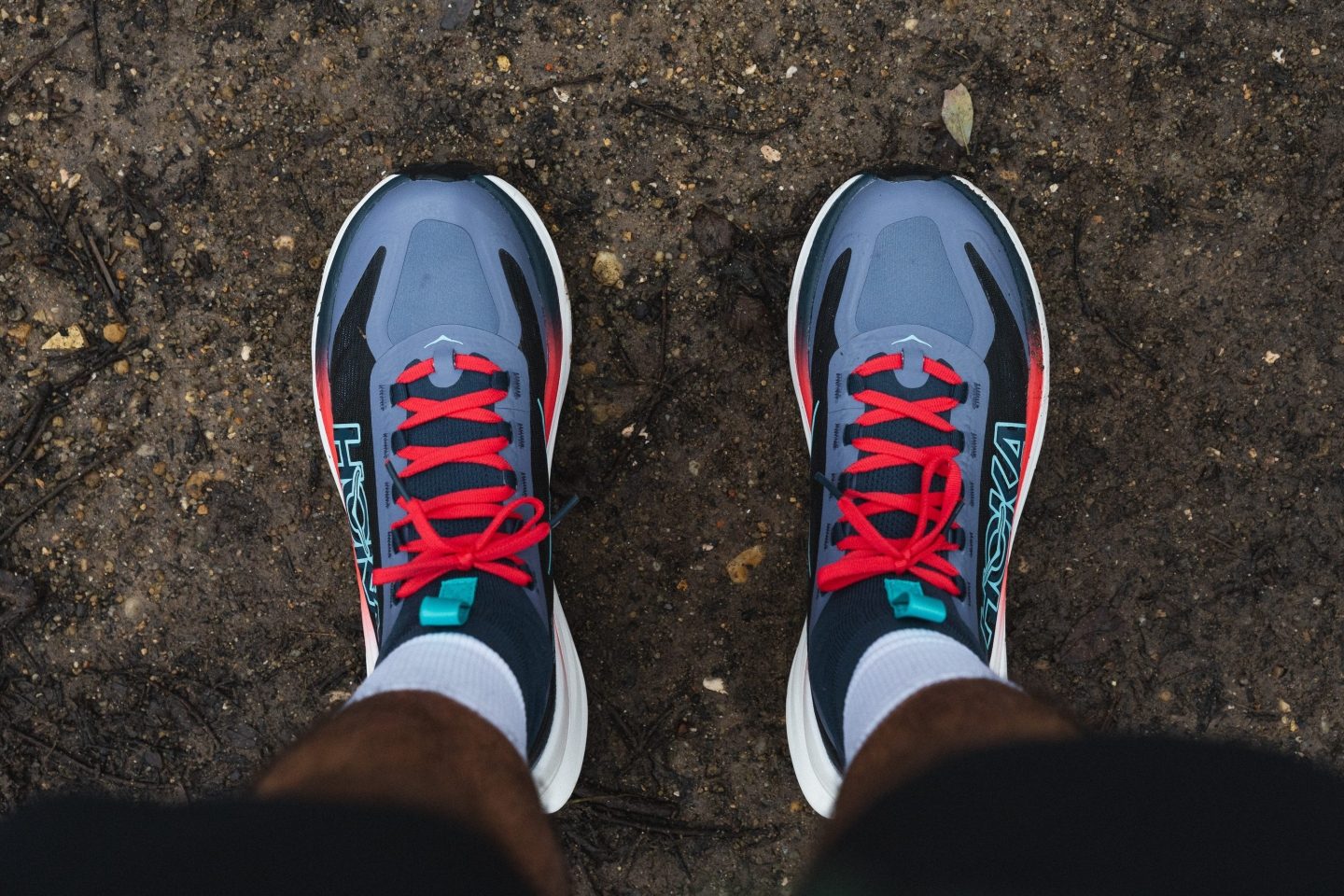
The Hoka Tecton X 3 (above) has a tough overlay on the upper that can cause issues for runners, despite the toebox being spacious. In contrast, the Hoka Challenger 7 (below) is much more forgiving because its upper is softer and more flexible in the toe area, without any hard TPU overlays.
We recommend that those who encounter this issue choose shoes with generous vertical space in the toebox, which can help decrease the likelihood of discomfort. Remember, though, that while ample toebox height is beneficial, it's not the only aspect to take into account.
A tight fit over the top of your foot, combined with a rigid material at the big toe, could spell trouble during long runs. On the other hand, a softer material may not cause discomfort, but it might lead to premature wear and tear, creating holes where your big toe presses against the shoe.
Finally, when testing out a new pair of shoes, pay special attention to how the upper material feels against the top of your foot. Consider whether it provides a comfortable fit or if it seems constricting.
What are foot-shaped toeboxes?
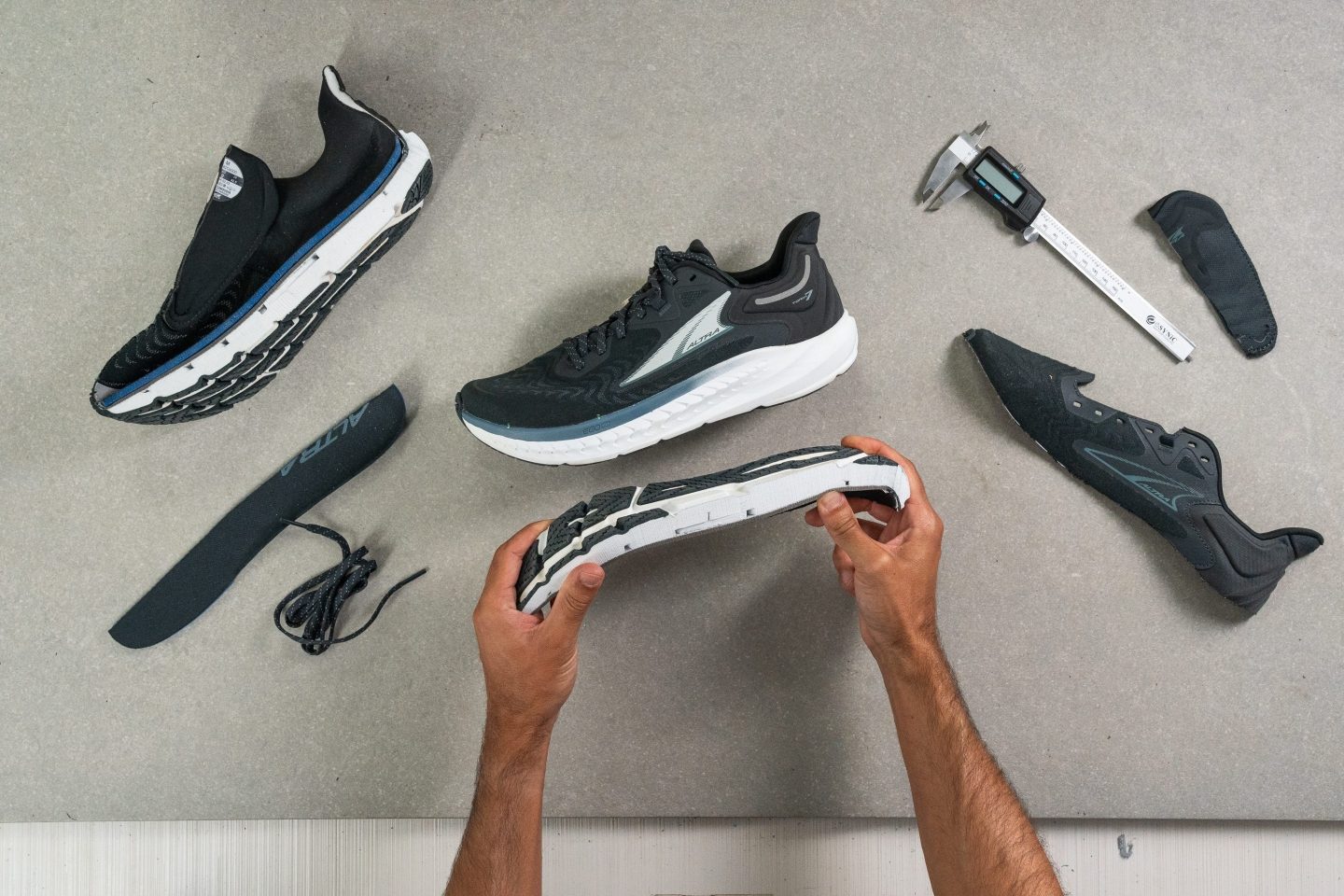
If you have a keen interest in footwear, you've likely noticed that most running shoes don't mirror the actual shape of a human foot. This conventional design is not an issue for the majority of runners; however, those with wider feet might find that shoes shaped like a human foot offer a more comfortable fit, especially if their feet are broadest at the toes.
For those who benefit from a more anatomical fit, there are brands dedicated to creating footwear that honors the natural silhouette of the foot. While several companies have ventured into this design space, Topo has established itself as a noteworthy contender.
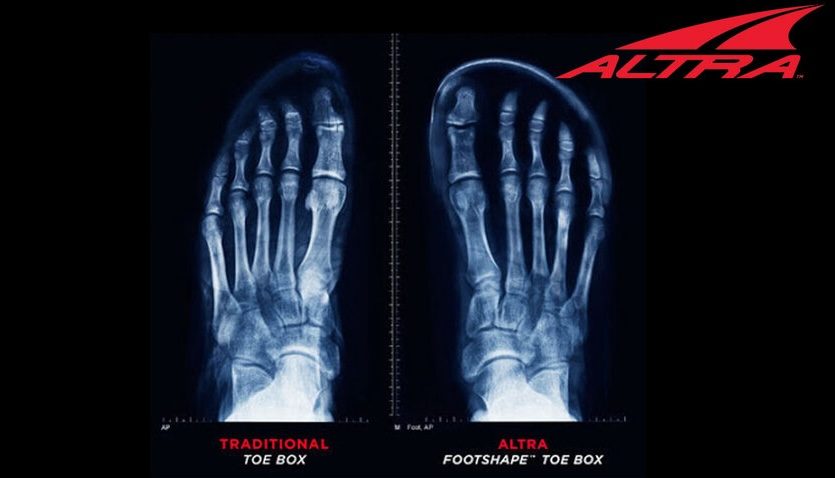
Yet, Utah-based Altra is the company that has truly pioneered and led the charge in foot-shaped shoe design, earning widespread recognition. Their commitment to this unique approach has not only differentiated them in a crowded market but also provided a fitting solution for runners seeking a shoe that respects the contours of their feet.
What sets apart a foot-shaped toebox from others?

The feature that sets a foot-shaped Altra apart from a conventional shoe is the toebox design. To make this clear, let's use a straightforward comparison.
| Shoe | Width (mm) | Big toe (mm) | Taper |
| Nike Pegasus 41 | 94.6 | 72.9 | 22.9% |
| Altra Torin 8 | 95.3 | 83.6 | 12.3% |
| Average shoe | 95.2 | 73.3 | 23.0% |
The contrast between a foot-shaped toebox and a conventional one is quite pronounced, particularly in the toe area. But this isn't to say that one is superior to the other. Much like the debate between soft and firm running shoe foams, it ultimately boils down to individual foot shapes and personal preferences.
While some runners thrive in traditional shoe designs, finding them to be perfectly comfortable, others may find that only a foot-shaped toebox allows for consistent, pain-free daily running. The real win for us as runners is the variety of choices available to suit every need and preference.
Don’t mistake toebox shape with toebox width

A frequent problem among runners is opting for a wide size in a specific shoe model, only to discover that it's still not comfortable. This discomfort often arises because, as highlighted at the start of this guide, every toe shape is distinct. Consider the five primary toe shapes depicted above—notice the significant variations among them?
For instance, a runner with a Greek foot type may have a wider foot but could still find a standard-width toebox quite suitable. Conversely, someone with a German or Roman foot shape may require a shoe with an exceptionally wide toebox, potentially even needing a foot-shaped shoe to accommodate their foot structure comfortably.
Understanding the specific shape of your feet is crucial. With this knowledge, you can make informed decisions when selecting both the model and the width of your running shoes.
How running socks can unexpectedly enhance toebox fit
Socks offer cost-effective solutions to common fit issues without the need to invest in new shoes. With most running shoes priced over $100, top-notch socks are a steal, often available for just $15 to $20.
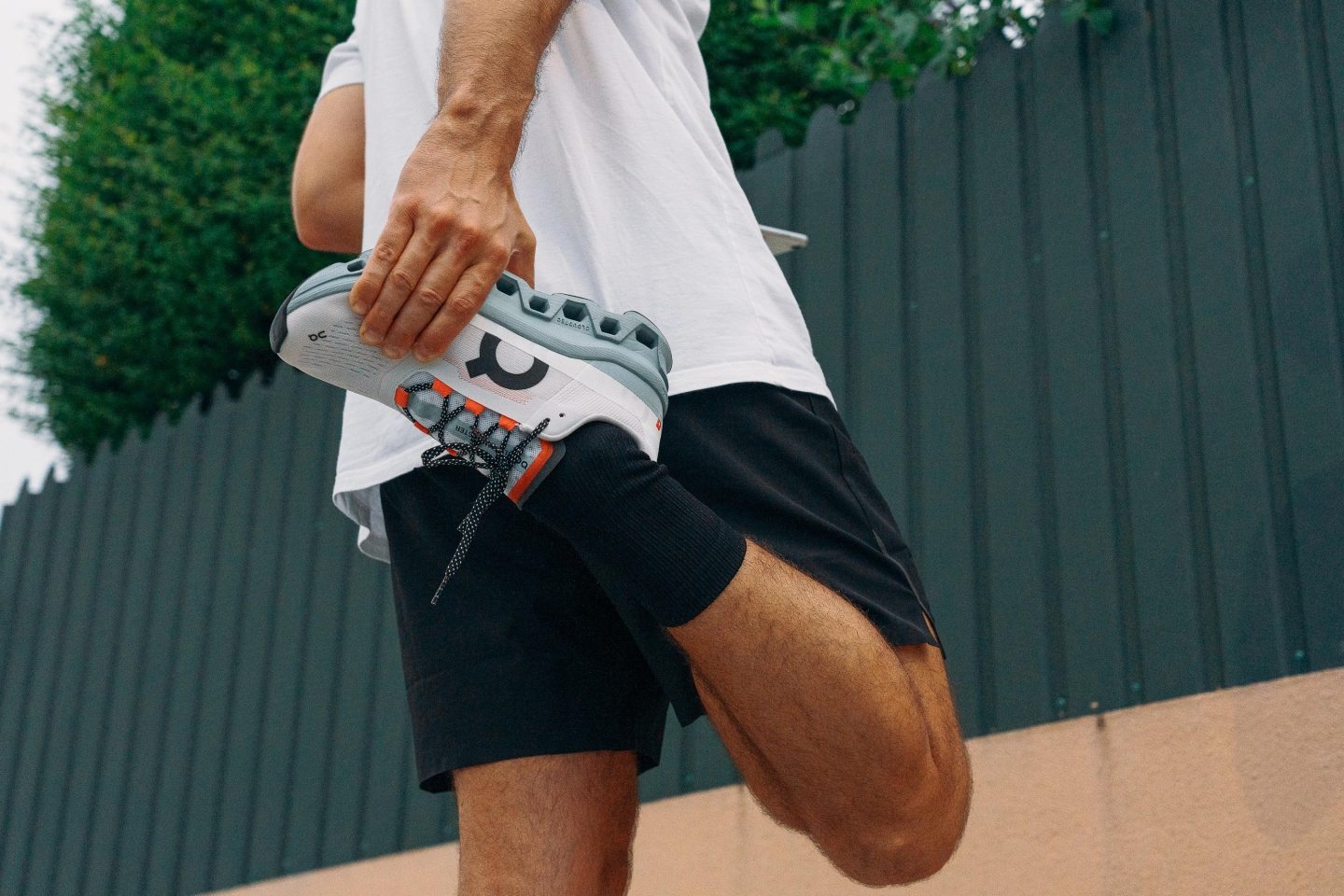
So, what's the best way to improve the fit of your running shoes using socks?
- Thin socks: Crafted from materials like nylon or polyester, these are ideal when your running shoe is nearly too snug, as an ultra-thin sock can even reduce your shoe size by half. They're also perfect for summer runs, thanks to moisture-wicking technology that keeps your feet cool and reduces swelling.
- Regular socks: These offer a middle-ground solution. Choose them when your shoe fit is just right, particularly in moderate weather or during the transitional seasons of spring and fall.
- Thick socks: If your shoe feels a bit loose or a half-size too big, thick socks can snug up the fit beautifully. They're also your go-to for chilly runs, providing warmth without sacrificing comfort. And some thick socks are specifically engineered for summer, boasting excellent breathability and heat dissipation!
Conclusion
Selecting the right toebox is a critical yet frequently neglected aspect of choosing running shoes. While many runners zero in on the midsole cushioning or the heel-to-toe drop, the toebox should not be an afterthought. An ill-fitting toebox is a common culprit behind discomfort and can even lead to injuries.
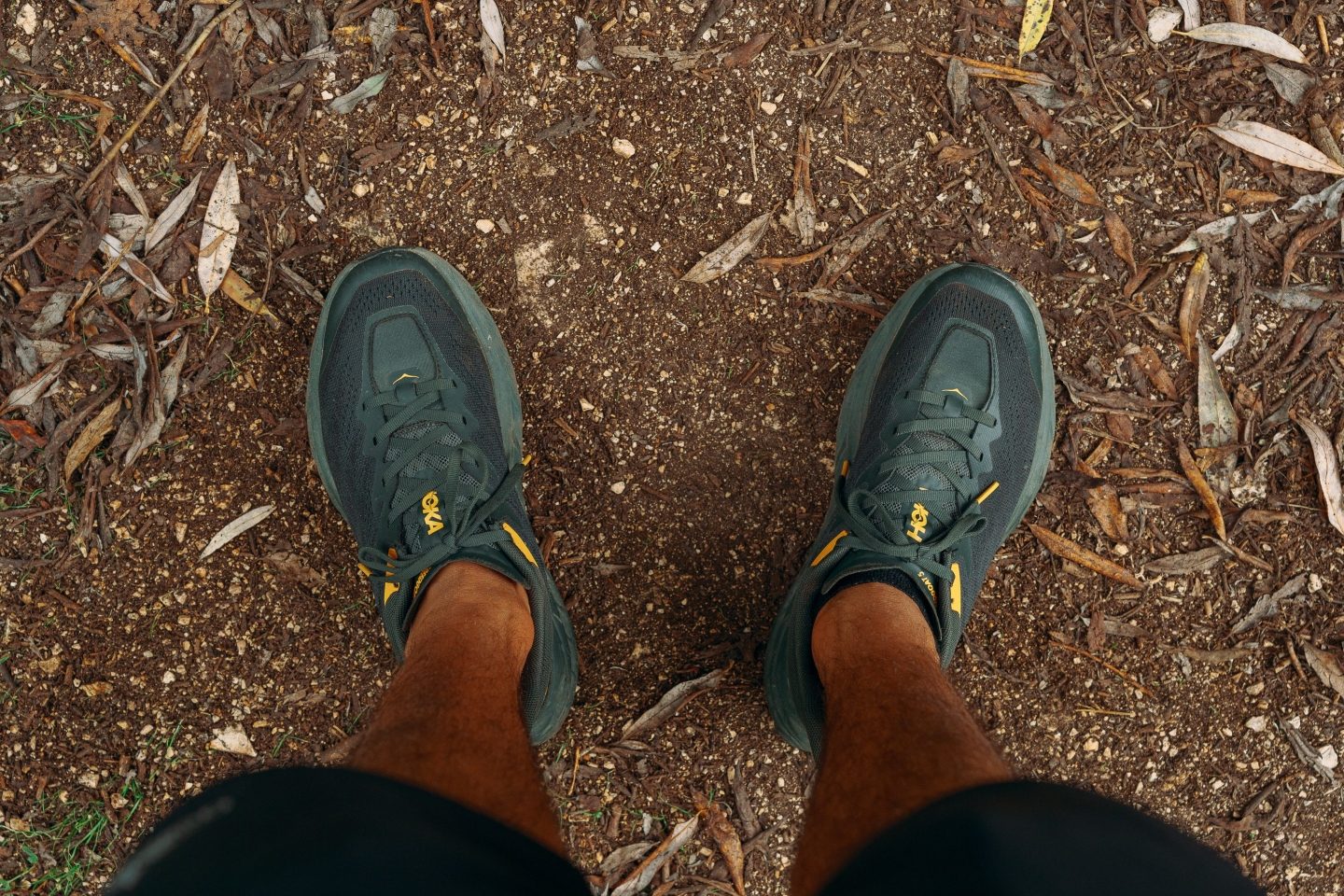
It's extremely rare to find thoroughness like ours in the lab, where we take not one, but two distinct measurements of the toebox, and this dedication to detail is part of why you can rely on RunRepeat. We independently purchase every running shoe we test, ensuring unbiased reviews, and our in-depth data on sizing and comparisons to other shoes allows you to make the most informed choice for your next pair of running shoes.
